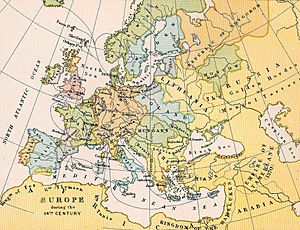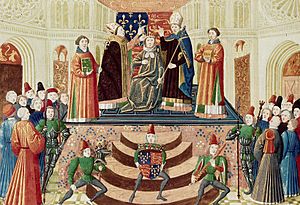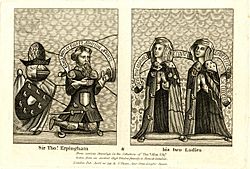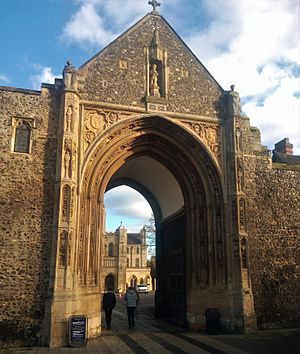Thomas Erpingham facts for kids
Quick facts for kids
Thomas Erpingham
|
|
|---|---|

|
|
| Born | c. 1357 |
| Died | 27 June 1428 (aged 72–73) |
| Resting place | Norwich Cathedral |
| Monuments | Erpingham Gate, Norwich |
| Nationality | English |
| Occupation | Soldier, administrator |
| Spouse(s) |
|
| Parent(s) |
|
Sir Thomas Erpingham (born around 1357 – died 27 June 1428) was an English soldier and government official. He was very loyal to three generations of the House of Lancaster royal family. This included serving King Henry IV and King Henry V. His military career lasted for 40 years. After the Lancasters took the English throne in 1399, his career grew. He became very important and gained much wealth and power.
Erpingham was born in Norfolk, England. He became a knight when he was young. During the time of Richard II, he served under the King's uncle, John of Gaunt, Duke of Lancaster. He fought in Spain and Scotland. He also went with Gaunt's son, Henry Bolingbroke, on crusades to Lithuania, Prussia, and the Holy Land.
Erpingham went into exile with Bolingbroke in 1398. He was with him when Bolingbroke returned to England in 1399. Bolingbroke wanted to get back his lands after King Richard took them. Bolingbroke rewarded Erpingham by making him the constable of Dover Castle and warden of the Cinque Ports. When Bolingbroke became King Henry IV, he made Erpingham the head of the royal household. Erpingham later helped stop a rebellion called the Epiphany Rising. He also became the guardian of Henry's second son, Prince Thomas. He was a member of the King's special council. He also tried to remove Henry le Despenser, a bishop who was against the Lancasters.
When Henry IV's son, Henry of Monmouth, became king in 1413, he made Erpingham the steward of the royal household. King Henry IV's time had been full of lawlessness. But Henry V and his officials were very skilled. Within a year, they brought law and order back to England. In 1415, Erpingham agreed to serve as a knight banneret. He joined Henry's campaign to get back his family's lands in France. Erpingham was in charge when the French city of Harfleur surrendered. On October 25, 1415, he led the archers at the Battle of Agincourt. He was positioned right next to the King.
Erpingham married twice, but he did not have any children. He gave money and support to the city of Norwich. He built the main cathedral gate there, which is named after him. He died on June 27, 1428. He was buried in Norwich Cathedral.
Contents
Sir Thomas Erpingham's Early Life
Thomas Erpingham was born around 1357. His father was Sir John de Erpingham. His family lived in Erpingham and Wickmere in Norfolk, England. His grandfather, Sir Robert de Erpingham, owned land in Erpingham in 1316 and 1346. Sir Robert also represented Norfolk in Parliament in the 1330s and 1340s.
Sir John, Thomas's father, owned a house in Norwich. Thomas might have been born there. We don't know who Thomas's mother was. In September 1368, Thomas might have traveled with his father to Aquitaine. They were serving Edward the Black Prince there.
Thomas's grandfather died in 1370. His father, Sir John, died later that same year, on August 1, 1370. Sir John was buried in the church at Erpingham.
Erpingham's Military Beginnings

Erpingham served under William Ufford, 2nd Earl of Suffolk in 1372. He was with Suffolk in France the next year. In 1379, he served under the Captain of Calais, William Montagu, 2nd Earl of Salisbury. In 1380, he joined the group of followers of John of Gaunt, Duke of Lancaster. Gaunt was a military leader and the third son of Edward III of England.
We don't know exactly when Erpingham became a knight. But in June 1380, he was called 'Sir Thomas' in a payment order from Lancaster. This is the earliest time his knighthood is mentioned. He received a good annual income of £20. Erpingham was with Lancaster during the English invasion of Scotland in 1385.
Lancaster wanted to rule the Kingdom of Castile (in Spain). This was because he married the Castilian princess Constance of Castile, Duchess of Lancaster in 1371. King Richard II of England agreed to give Lancaster money for a campaign in Castile in 1386.
Erpingham went with Lancaster's army from Plymouth in July 1386. They landed in France and helped the English soldiers in Brest, France. Then they went to A Coruña in Spain and took control of Galicia. John I of Portugal joined them in March 1387. But they ran out of food for their animals. The Spanish also used good defense tactics. So, their campaign ended after six weeks. In 1388, Erpingham took part in a jousting tournament in France. He was knocked off his horse but managed to continue.
Erpingham was sent back to England to look after Lancaster's son, Henry Bolingbroke. He then joined Bolingbroke's service. In 1390, he was with Bolingbroke when they tried to join a crusading trip to Tunisia. But the French king would not let them travel through France. Bolingbroke then went on a crusade in Lithuania. Erpingham was one of Lancaster's most trusted men. He was part of the older, more experienced group sent to guide and protect Bolingbroke. This "crusade" involved an unsuccessful attack on Vilnius. They captured Lithuanian women and children and made them Christian.
Erpingham was with Bolingbroke when he returned to Prussia in 1392. Bolingbroke and his group traveled through Europe and the Near East. They visited Prague, Vienna, Corfu, and the Holy Land. It is thought that Erpingham got silk in Italy for a special church garment that is now in the Victoria and Albert Museum.
The Change of Kings in 1399
Erpingham became the most important of Lancaster's supporters in the East Anglia region. He was given power to keep order in Norfolk after the Peasants' Revolt in 1381. He also helped supervise the defense of Norfolk in 1385, when a French invasion seemed likely. In 1396, Lancaster gave him the right to use land in South Erpingham. This was a reward for his loyal service.

In 1398, a disagreement started between Bolingbroke and Thomas de Mowbray, 1st Duke of Norfolk. King Richard ordered them to settle it with a fight. But Richard stopped the fight just as it was about to begin. He banished Bolingbroke from the kingdom for ten years and Mowbray for life. People at the time thought Richard's decision was an act of revenge. Bolingbroke had rebelled against Richard in 1387.
Erpingham was one of 17 friends who chose to go with Henry Bolingbroke into exile. He left his lands and property with friends. They went to Paris, where the French king welcomed them. Bolingbroke's father died in 1399. King Richard then took all of Bolingbroke's inheritance and banished him for life. In June 1399, Erpingham witnessed a secret agreement in Paris. Bolingbroke and the Duke of Orléans agreed to support each other against their enemies.
Erpingham was one of Bolingbroke's supporters who landed with him in England in June 1399. Bolingbroke was gathering support to get back his lands. King Richard was delayed in Ireland. He eventually reached Wales. Realizing the danger, he left his court and traveled with a small group.

By July 27, Bolingbroke reached Berkeley. There, Richard's uncle, the Duke of York, left the King and joined Bolingbroke. Soon after, Erpingham arrested Henry le Despenser, the bishop of Norwich. He was one of the few who still supported Richard.
Richard was at Conwy Castle when Bolingbroke took Chester on August 5. The Earl of Northumberland convinced the King to leave Conwy. But during the journey, Richard's group was ambushed. He was taken prisoner. A French story says that Erpingham led the men who ambushed Richard. Richard was taken to London and held in the Tower of London. Bolingbroke and his representatives, including Erpingham, forced Richard to give up his throne.
Bolingbroke gave Erpingham two important jobs. He was made the head of Dover Castle and the Lord Warden of the Cinque Ports by August 21. After Henry became king, Erpingham was made the head of the royal household. This job meant he was in charge of the King's home life. He held this position until 1404. As constable of Dover, he was paid over £300 a year.
Erpingham's Role Under King Henry IV
Henry's coronation was on October 13, 1399. Erpingham carried one of the King's swords during the ceremony. He was one of 11 men who asked Henry in person to have Richard killed. Erpingham was a commander in the army that stopped the Epiphany Rising in 1399-1400. This rebellion was led by noblemen who had supported Richard. Erpingham oversaw the execution of two rebel leaders. One of them, Sir Thomas Blount, cursed Erpingham.
Henry rewarded Erpingham with a house in London for life. The next year, Erpingham became the guardian of the King's second son, Prince Thomas. Around 1401, he joined the Order of the Garter. He also briefly served as the head of the royal household that year. In October, he became the acting Earl Marshal of England. In 1407, Erpingham led a group to Paris to discuss peace between France and England.
Even though his job at Dover Castle was military, Erpingham did not fight much in the early years of Henry IV's reign. He usually stayed at court. He did campaign in Scotland in 1400.
Some people believed Erpingham supported John Wycliffe's English translation of the Bible. This was seen as against the Church's teachings. It is said that Erpingham was not punished because King Henry IV favored him. He supposedly paid a fine, which helped build the Erpingham Gate. However, some historians think it's unlikely he supported Wycliffe. If he had a dispute with the Church, it was more likely about his arrest of Bishop Despenser.
Power in Norfolk
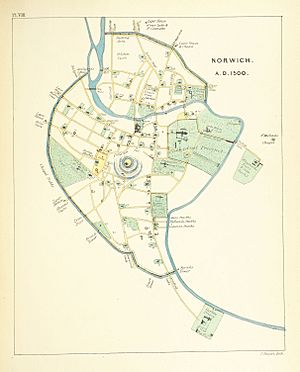
Sir Thomas Erpingham was very close to King Henry IV. After 1399, power in Norfolk moved from Bishop Despenser to Erpingham and his friends. Because of his local connections and his position in the government, Erpingham was very important in East Anglia. He was part of every group that worked to keep peace in Norfolk during Henry IV's reign.
During the 1400s, Erpingham's power grew to other parts of Norfolk and into Suffolk. Many important people from East Anglia who knew Erpingham benefited from his powerful position. For example, Sir John Strange became head of the royal household in 1408. Sir Robert Gurney became Erpingham's assistant at Dover Castle in 1400. John Winter became head of Prince Henry's household in 1403.
The people of Norwich were unhappy with King Richard II. The city had lost its special rights in 1388. Bishop Despenser had stayed in his area after Henry became king. But his nephew was executed for his part in the Epiphany Rising. Erpingham tried to have Despenser removed from his position for supporting the rebels. Norwich asked King Henry to charge Despenser, and Erpingham presented these charges.
At Despenser's hearing, the King publicly praised Erpingham for his loyalty. Despenser had to accept Henry's authority and was publicly criticized. He was later pardoned. Henry gave Norwich a new charter, which restored its rights. The city thanked Erpingham with gifts for speaking to the King on their behalf. The city leaders worked with him because he was an important person in Henry's inner circle.
Erpingham's Role Under King Henry V
King Henry IV died on March 30, 1413. His son, Henry of Monmouth, became king. Monmouth had replaced Erpingham as warden of the Cinque Ports in 1409. But they still had a good relationship. After Henry V's coronation in 1413, Erpingham was made steward of the household again. He held this job until at least 1415. King Henry V quickly worked to bring law and order back to England. His officials, including Erpingham, were very skilled. Order was kept throughout his reign.
Henry V wanted to get back lands in France that his great-grandfather, Edward III, had lost. In November 1414, Henry started a campaign to take back these lands. This was a good way for him to show his power as king. In February 1415, Erpingham and other soldiers helped plan the expedition. Erpingham agreed to serve as a knight banneret. His group included two knights, 17 squires, and 60 archers.
At Harfleur and Agincourt
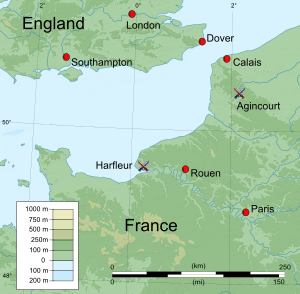
Erpingham crossed from England to Normandy with Henry's army on August 11, 1415. The army landed near Harfleur. Erpingham's men were part of the siege of the town. On September 22, he led the group to the town's walls and oversaw the agreement that led to its surrender. The English army then marched towards Calais. The French army followed them, forcing them to change their route. The English successfully crossed the River Somme. Two days before reaching Calais, they were blocked by the French near Agincourt.
Erpingham was one of the older English commanders at the Battle of Agincourt. At 60 years old, he was one of the oldest men there. He had not been in a large battle before. But he was very experienced from smaller fights. He was "undoubtedly one of the most experienced soldiers present" at Agincourt. French writers described his important role in the battle. The English army had three main parts. Henry led one, and two experienced soldiers led the others.
The Battle
On October 25, the day of the battle, the English army was ready by dawn. Their sides were protected by woods. The army had 5,000 archers and 800 dismounted men-at-arms. Erpingham was given command of the archers because of his experience. Most archers were on the sides of the men-at-arms. Some were hidden in the woods near the French lines. Each archer had a sharp, double-pointed stake, six feet long. They planted these stakes in the ground to protect against French cavalry attacks.
The French army did not attack first. Erpingham was ordered to tell the army to move closer to the French. He threw his stick upwards as a signal to advance. He commanded, "Now strike!" He then got off his horse and joined the King, where he stayed for the rest of the battle.
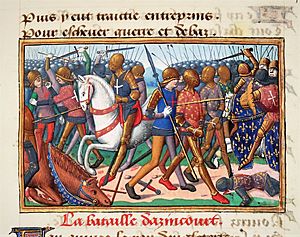
When the English advanced with a loud shout, the French also started to move. The English paused and replanted their stakes. Then they began to shoot arrows continuously. This signaled the hidden archers to start firing into the French sides. The French plan was to use mounted men-at-arms to defeat the English archers. But this plan failed. The French cavalry were stopped by the arrows and the stakes. Their retreat was disrupted by their own advancing foot soldiers. This caused chaos, allowing the English men-at-arms to break through the French lines.
The fighting that followed was the most important part of the battle. Once the men-at-arms from both armies met, the English archers fired into the sides of the French. The English soldiers, especially those led by the Duke of York (who was killed), did most of the fighting. The French were tired from advancing through deep mud. Those killed or knocked down at the front blocked others behind them. The French who could not move were killed. The English had far fewer casualties. Any French trying to retreat were blocked by their own advancing comrades. If they tried to move to the sides, they were targets for the English archers. At this point, the archers stopped using their bows. They attacked the sides of the French with any weapons they had. This, and their bad position, caused the French to break. Many were killed or captured by the English. Most of the French army then left the field.
After the Battle
After the battle, Henry's army marched to Calais. They sailed back to England on November 16. Erpingham was among 300 men-at-arms and 900 archers who stayed in Calais for the winter. These important soldiers were there to make sure the French did not take the town.
When he returned to England, Erpingham was rewarded for his service. He received land and an annual payment from the King. In July 1416, he traveled back to Calais. There, he welcomed the Duke of Burgundy before his meeting with King Henry.
Erpingham's Family and Later Life
When in Norwich, Erpingham and his family lived in a large house. It was located between Norwich Cathedral and the River Wensum. He bought the house in 1409. No parts of the house remain today. It was a major source of jobs for the local area when Erpingham lived there. His niece later inherited it.
Erpingham's connections to the Lancasters and his growing wealth helped him gain lands and properties. He held over 40 estates during his life. Three were inherited from his father. Seven came to him in the 1370s and 1380s. King Henry IV gave him eight estates in 1399. He gained another seven that year in other ways. Seven more were acquired in the 1400s. He bought twelve estates from 1410 to 1421. He also lost some lands, which was common at the time. In 1407, he bought land at Blickling. His family sold Blickling in 1431.

Erpingham married Joan Clopton before 1389. She died in 1404. His second marriage was to Joan Walton. She was the widow of Sir John Howard and died in 1425. Erpingham had no children from either marriage.
Erpingham greatly influenced the careers of his sister Julian's two sons. His position at court helped the older son, William, become part of Henry IV's household. William's brother John had a similar job at Henry V's court. The brothers stayed close to their uncle. William and Erpingham often owned estates together. William also helped his uncle with financial matters. The family's fortunes improved when Henry V became king. John died at Harfleur in 1415. William was knighted before the coronation and fought at Agincourt.
From 1417, Erpingham seems to have retired. He lived his remaining years in Norfolk. He gave up his position as steward in May 1417. King Henry V died in 1422. After that, Erpingham had no more contact with the court. He died on June 27, 1428. He was buried in Norwich Cathedral. Sir William Phelip inherited his uncle's many possessions in Norfolk. Erpingham's will, dated March 25, 1427, left gifts to Norwich Cathedral, churches, hospitals, and convents. He also stated that his armor should be given to Norwich Cathedral.
Erpingham's Buildings
Erpingham was a generous supporter of the city of Norwich. In 1420, he built the cathedral gate that is named after him. It is opposite the west door of Norwich Cathedral. He also paid for the rebuilding of the Church of the Blackfriars in Norwich. This church was damaged by a fire in 1413. Today, it is one of the most complete friaries still standing in England. He also paid for the west tower of St. Mary's Church in the village of Erpingham.
In 1419, Erpingham paid for a stained glass window in the church of St. Austin's Friary in Norwich. The window showed dedications to 107 noblemen or knights who died without children since the time of Edward III. The building was torn down in 1547.
Erpingham in Shakespeare's Plays
Sir Thomas Erpingham appears twice in Act IV of William Shakespeare's play Henry V, first printed in 1600. He is also mentioned in Act II of Richard II, but he does not appear in person.
In Henry V, Erpingham plays an important role. He enters and the King acknowledges him. As the old man leaves, Henry says, "God-a-mercy, old heart! thou speak'st cheerfully." Later in the same scene, Erpingham returns to tell the King that his nobles are looking for him. Erpingham's short appearance in the play contrasts with the much larger part of the character John Falstaff. Henry emphasizes Erpingham's old age and goodness.
In movies based on the play, Erpingham's part is usually silent. In Laurence Olivier's 1944 film of Henry V, Erpingham appears near the end, the night before the Battle of Agincourt. Kenneth Branagh, in his 1989 film, used the character more often. He showed more awareness of Erpingham's place in history. In both films, Erpingham is recognized by his unique coat of arms and white hair. Branagh includes Erpingham in court scenes and during the battle. He gives the character a more central role without changing Shakespeare's original ideas.


